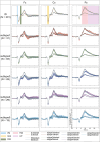One size fits null: attentional brain responses differ depending on insomnia subtype
- PMID: 40398872
- PMCID: PMC12246374
- DOI: 10.1093/sleep/zsaf056
One size fits null: attentional brain responses differ depending on insomnia subtype
Abstract
Study objectives: Event-related potential (ERP) studies on attentional brain processes in insomnia disorder (ID) have yielded inconsistent findings. Such inconsistencies may relate to small sample sizes, limited corrections for multiple comparisons, and the possibility of heterogeneity within the clinical population. We aimed to overcome these limitations by studying ERP responses both across and within subtypes in a larger sample of ID.
Methods: ERPs were recorded in 201 participants with ID and 70 normal sleeper controls (NS) with an auditory oddball task. Participants with ID were subtyped using a validated multivariate trait profile. Analyses evaluated subtype-specific and nonspecific deviations using both conventional ERP components as well as cluster-based permutation tests.
Results: All five subtypes were well-represented in the ID sample (subtypes 1-5 respectively N = 31, 83, 28, 29 and 19). ERP component analyses with false discovery rate corrections revealed no evidence for differences between the heterogeneous ID group and NS. However, subtype-specific analyses revealed that ERPs were significantly altered, but in different ways for different subtypes. Specifically, ERP component analyses revealed stronger N100 amplitudes for standards and deviants both in subtypes 2 and 3, and a lower P300 amplitude and longer P300 latency for deviants in subtype 3. Cluster-based permutation tests on ERPs corroborated the P300 amplitude effect for deviants in subtype 3, with subtype 3 and 4 additionally showing a smaller difference between deviant and standard P300 amplitudes.
Conclusion: Our findings indicate that ID is a heterogeneous disorder. Ignoring subtype identity dilutes ERP alterations occurring only in specific insomnia subtypes.
Keywords: auditory oddball; event-related potentials; insomnia disorder; insomnia subtypes.
© The Author(s) 2025. Published by Oxford University Press on behalf of Sleep Research Society.
Conflict of interest statement
Financial disclosure: The authors have no financial disclosure.
Nonfinancial disclosure: The authors have no conflicts of interest to declare.
Figures




Comment in
-
New electrophysiological evidence for five insomnia disorder subtypes.Sleep. 2025 Jul 11;48(7):zsaf069. doi: 10.1093/sleep/zsaf069. Sleep. 2025. PMID: 40411526 Free PMC article. No abstract available.
Similar articles
-
Home treatment for mental health problems: a systematic review.Health Technol Assess. 2001;5(15):1-139. doi: 10.3310/hta5150. Health Technol Assess. 2001. PMID: 11532236
-
Omega-3 fatty acids for depression in adults.Cochrane Database Syst Rev. 2015 Nov 5;2015(11):CD004692. doi: 10.1002/14651858.CD004692.pub4. Cochrane Database Syst Rev. 2015. Update in: Cochrane Database Syst Rev. 2021 Nov 24;11:CD004692. doi: 10.1002/14651858.CD004692.pub5. PMID: 26537796 Free PMC article. Updated.
-
Diagnostic test accuracy and cost-effectiveness of tests for codeletion of chromosomal arms 1p and 19q in people with glioma.Cochrane Database Syst Rev. 2022 Mar 2;3(3):CD013387. doi: 10.1002/14651858.CD013387.pub2. Cochrane Database Syst Rev. 2022. PMID: 35233774 Free PMC article.
-
Music for insomnia in adults.Cochrane Database Syst Rev. 2015 Aug 13;2015(8):CD010459. doi: 10.1002/14651858.CD010459.pub2. Cochrane Database Syst Rev. 2015. Update in: Cochrane Database Syst Rev. 2022 Aug 24;8:CD010459. doi: 10.1002/14651858.CD010459.pub3. PMID: 26270746 Free PMC article. Updated.
-
Pharmacological treatments in panic disorder in adults: a network meta-analysis.Cochrane Database Syst Rev. 2023 Nov 28;11(11):CD012729. doi: 10.1002/14651858.CD012729.pub3. Cochrane Database Syst Rev. 2023. PMID: 38014714 Free PMC article.
Cited by
-
New electrophysiological evidence for five insomnia disorder subtypes.Sleep. 2025 Jul 11;48(7):zsaf069. doi: 10.1093/sleep/zsaf069. Sleep. 2025. PMID: 40411526 Free PMC article. No abstract available.
References
-
- Riemann D, Baglioni C, Bassetti C, et al. European guideline for the diagnosis and treatment of insomnia. J Sleep Res. 2017;26(6):675–700. doi: https://doi.org/ 10.1111/jsr.12594 - DOI - PubMed
-
- Morin CM, Vézina-Im LA, Ivers H, et al. Prevalent, incident, and persistent insomnia in a population-based cohort tested before (2018) and during the first-wave of COVID-19 pandemic (2020). Sleep. 2021;45(1). doi: https://doi.org/ 10.1093/sleep/zsab258 - DOI - PMC - PubMed
-
- Riemann D, Benz F, Dressle RJ, et al. Insomnia disorder: state of the science and challenges for the future. J Sleep Res. 2022;31(4):e13604. doi: https://doi.org/ 10.1111/jsr.13604 - DOI - PubMed
-
- Wardle-Pinkston S, Slavish DC, Taylor DJ.. Insomnia and cognitive performance: a systematic review and meta-analysis. Sleep Med Rev. 2019;48:101205. doi: https://doi.org/ 10.1016/j.smrv.2019.07.008 - DOI - PubMed
-
- Dressle RJ, Riemann D.. Hyperarousal in insomnia disorder: current evidence and potential mechanisms. J Sleep Res. 2023;32(6):e13928. doi: https://doi.org/ 10.1111/jsr.13928 - DOI - PubMed
MeSH terms
Grants and funding
LinkOut - more resources
Full Text Sources
Medical
Miscellaneous

